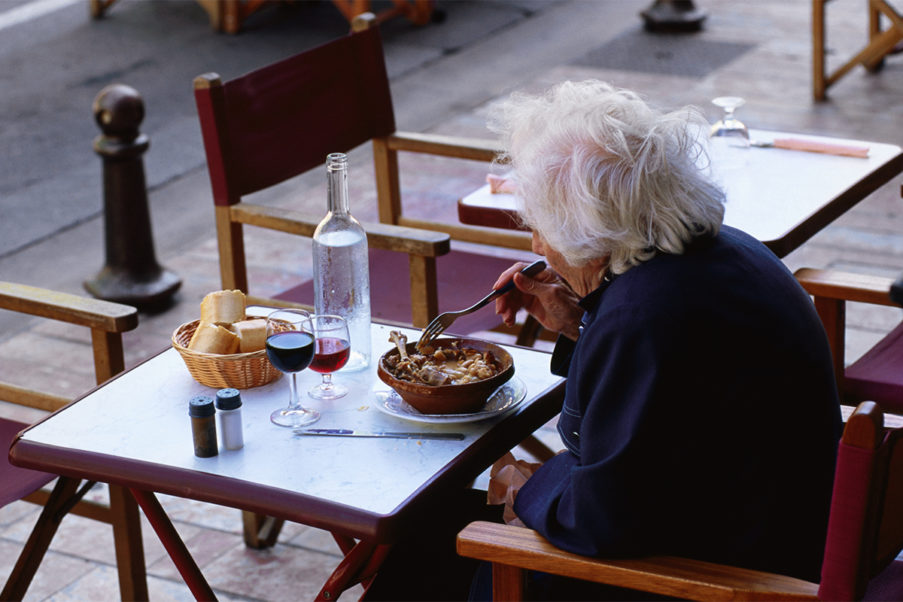Navigating Restaurant Menus
How to help clients make healthier choices when eating out.
| Earn 1 CEC - Take Quiz

Growing up, I learned to view restaurant cuisine as a rare treat. Rare enough that I developed a restraint-free menu mentality: restaurant meals were about as frequent as blue moons, so I could pretty much order whatever I wanted off any menu with little consequence to my long-term well-being. I suspect many of us grew up thinking the same way.
Fast-forward to the present. A good number of us now have the money, occasion and social impetus to dine out more frequently, regardless of the caloric consequences of restaurant meals, fast-food lunches, sugar-filled coffees and ubiquitous snacks. Research bears this out: just under half (47.9%) of all 2010 food dollars in the U.S. were spent on “away-from-home” foods (USDA 2012), a category that includes, albeit not exclusively, restaurant meals and on-the-go fare. This percentage represents an almost twofold increase since 1970 (Todd & Mancino 2010).
As a fitness professional, you have the unique opportunity to educate your clients on restaurant food realities. Read on to discover strategies for successfully navigating restaurant menus and eating out healthy.
Fattening and Frequent: The Real Skinny on Restaurant Food
According to a 2010 USDA report, eating just one meal at a restaurant adds an average of 134 calories to your daily energy intake, so a once-a-week dining-out habit translates to roughly 2 pounds gained per year (Todd, Mancino & Lin 2010). Now consider that most Americans eat away from home an average of 5.8 times per week—a fifth of their meals and a third of their total calorie intake (Berman & Lavizzo-Mourey 2008)—and the importance of bolstering your clients’ eating-out expertise becomes clear.
Nutritional quality is also at stake. Restaurant foods contain more calories, total fat, saturated fat, sodium and cholesterol, and less fiber, calcium and iron, than foods prepared at home (Guthrie, Lin & Frazao 2002).
However, there is good news. Three out of four adults (73%) now say they are trying to make healthier selections when dining out (NRA 2010). And a 2011 survey of professional chefs showed that nearly all (93%) thought that the calories in menu items could be reduced 10%–25% without customers detecting a difference (Obbagy et al. 2011).
In addition, consumer knowledge is about to expand. Following the examples of places like California, Oregon and New York City, new federal guidelines will soon make restaurant meal calories clear. Section 4205 of the 2010 Patient Protection and Affordable Care Act (“Obamacare”) stipulates that U.S. restaurant chains with more than 20 locations must visibly post the caloric content of all menu items and make detailed nutrition information available on request (FDA 2011), updates likely to be enacted within the next year (Federal Register 2011).
With all that in mind, consider these practical strategies for helping clients successfully navigate restaurant menus and align their culinary customs with their fitness goals.
Step 1: Plan Before Eating
Cultivate Awareness
Simply helping clients become more aware of restaurant habits to prevent mindless eating is a good place to start, says Mary Jane Detroyer, MS, RD, dietitian, exercise physiologist and ACE-certified personal trainer. To kick-start the conversation, visit www.HealthyDiningFinder.com, a dietitian-driven website published by Healthy Dining, based in San Diego. The Finder sorts name-brand restaurants by zip code and identifies the more healthful menu choices, including “Sodium Savvy” and “Kids LiveWell” selections. Nutrition information is included for all recommended dishes.
Set Client Goals
Help your clients create proactive, behavior-specific goals, says Detroyer. Make it a step-by-step process to improve restaurant choices; for example, not indulging in any restaurant desserts this week, and ordering a side of vegetables at all dine-out dinners this month.
Look for Online Info
Restaurants with easy-to-find online nutrition information have much lower caloric, fat and sodium content across all menu offerings than eateries that provide information only upon request, a recent study found (Wu & Sturm 2012). There’s a chicken-or-egg debate about why: Are establishments with healthier items more willing to post nutrition information, or does being required to post food facts—whether because of local regulations or in response to consumer concerns—drive restaurants to create healthier options? Either way, encourage clients to check online offerings before making dining decisions.
Review the Menu
During a less-intensive portion of training sessions, such as the end-of-workout stretches, conduct a brief menu assessment of the client’s favorite restaurant. To stay on track, set a discussion time limit and stick to it.
You can point out which items might have hidden fats and sodium and which foods contain whole grains, Detroyer says. And you can refer trainees to the Daily Food Plan at www.ChooseMyPlate.gov, a free online tool where they can calculate their daily caloric requirements. That will come in handy once restaurant calorie contents are made public nationwide.
Put the App in Appetizer
Look for smartphone apps that help clients monitor their meals. For instance, Healthy Dining offers an iPhone app called yumPower, a free download in the App Store. “All Healthy Dining–approved menu items are listed [for participating restaurants], along with corresponding nutrition information,” says dietitian Lauren Rezende, MPH, RD, director of nutrition for Healthy Dining. The app can also help you find zip code–specific menu choices in a variety of customized categories, including fiber-rich foods and dining for diabetics.
Step 2: Make the Most of the Menu
Ask for Details
While deep-fried fast foods are clear culinary culprits, they are not the only concern. A recent review of over 28,000 menu items in 245 major U.S. chain restaurants found that main entrées in “family-style” restaurants had more calories, fat and saturated fat than fast-food restaurant choices (Wu & Sturm 2012).
To overcome this trend, encourage your trainees to ask the waiterhow and with what a dish is prepared. For example, are the veggies steamed and then served, or steamed and doused with flavorful butter? “Even terms like broiled, grilled and steamed don’t guarantee a low-fat preparation,” Rezende says.
Get Word-Wise
Teach your clients to read between the lines on menu descriptions. Terms such as bisque, smothered, aioli, carbonara and en croute all signal a serious caloric punch, says Detroyer.
Step 3: Order Astutely
Suggest Substitutions
Encourage clients to find out what comes with their meals, says Rezende. “If it’s served with fries or garlic mashed potatoes, request steamed brown rice or a plain baked potato instead.” Or ask the chef to use olive oil instead of butter, says Ryan Johnston, executive chef and partner at restaurants Whisknladle and Prepkitchen in San Diego.
Such requests are common, adds Johnston. He says chefs are accustomed to special dietary considerations and often see them as an opportunity to get creative on the spur of the moment.
Request the Healthiest Dish
Substitutions won’t always work, such as when the flavor profile of a healthier ingredient or method of preparation does not complement the overall meal. “I try to use heart-healthy oils whenever possible, but sometimes butter or bacon fat is needed for the flavor of a specific dish, and olive oil would change the dish entirely,” says Sean Brasel, executive chef and restaurant co-owner at Meat Market in Miami Beach.
Instead, “if health is the concern, I recommend that my customers say so at the beginning of the meal and then, as the chef, I can suggest the healthiest menu items,” Brasel says. For seafood orders, ask the chef (via your waiter) what fish he or she thinks is the freshest and order it, he adds.
Go for Greens
Away-from-home dishes contain up to a third less fruit, vegetables and whole grains than at-home meals, and levels of whole fruit and dark-green and orange vegetables are hit particularly hard (Todd, Mancino & Lin 2010). To counter this, encourage clients always to order a side of vegetables, says Detroyer, and ask how they are prepared. The best bet? Steamed veggies without butter, oil or cream sauce.
Step 4: Manage the Meal
Overcome Portion Distortion
A recent study found that 3 out of 4 chefs (76%) felt they served “regular” portions, despite serving steak and pasta meals that were two to four times larger than federal recommendations (Condrasky et al. 2007).
To sidestep supersized selections, clients can consider sharing an entrée with a friend, and ordering an extra salad, says Rezende. They could also piece together a healthy meal by pairing an appetizer with a side dish, as HealthyDiningFinder.com suggests. Bear in mind, though, that restaurant appetizers have more calories, fat and sodium than any other category of menu item (Wu & Sturm 2012).
Take It To Go
Clients do not have to feel stuffed after a meal to get value for their dollar, Johnston says. Instead, he suggests, they can ask the waiter to wrap up half of their entrée before digging in.
Splurge Sensibly
Birthdays, holidays, weddings . . . sometimes only the real meal will do. For special-occasion splurges, clients should just order the high-calorie entrée they really want, says Detroyer. However, encourage them to eat slowly and stop when they are full. Detroyer believes this helps prevent the mindless nibbling that might happen when they get home because they feel deprived of a much-desired, special-occasion treat.
Choosing a Dine-Out Detour
“Many of my clients eat 50%–85% of their meals out at a restaurant or by ordering in,” says Detroyer, who works in restaurant-rich New York City.
Consider how often Average Joe and Jane consume restaurant meals, take-out treats and calorie-rich coffees, and it’s easy to see the enormous impact these habits have on waistlines and well-being. To improve your clients’ dietary success, get beyond groceries and address the other lists that deeply influence results: restaurant menus.
Red-Flag Terms on the Menu
Help clients learn which words signal healthier choices and which lead to dietary derailments, says nutrition and fitness expert Mary Jane Detroyer.
Dietitian Lauren Rezende offers these examples:
- Look for grilled, steamed, poached, baked, roasted and braised.
- Avoid battered, buttery, scalloped, crispy, creamed, creamy, fried, rich, in cheese sauce, hollandaise, bearnaise, tempura, with gravy, au gratin, Alfredo, breaded, croquettes, á la king, Newburg and deep fried.
- For sodium concerns, avoid smoked, broth, creole sauce, tomato base, fish sauce, barbecued, soy sauce, marinated, Parmesan, hoisin sauce, pickled, teriyaki, cocktail sauce, mustard sauce and chili paste.
More Dining-Out Dos
Healthy Dining’s dietitians recommend these culinary caveats:
- Choose dishes flavored with herbs and spices instead of rich sauces, gravies or dressings. Get sauces on the side and use them sparingly.
- Order a broth-based (not cream-based) soup or salad (dressed lightly or with dressing on the side, used sparingly) to help fill up before a meal.
- Order meals where vegetables or fruits are a major component.
- For a lower-calorie dessert, try fresh fruit, sherbet or sorbet, or angel food cake with fruit topping.
- Ask for extra lettuce, tomato and other vegetables on sandwiches and burgers.
Staying Within Your Scope
Chances are, you’re not a dietitian. Nevertheless, 77% of IDEA members who responded to the 2011 IDEA Fitness Programs & Equipment Trends survey provide some sort of nutritional service to their clients (Davis & Davis 2011). When you’re on the front lines of fitness, what’s the best way to give good advice yet stay within your scope of practice?
Encourage clients to see you not as a nutrition expert but as a knowledgeable resource, says RD and personal trainer Mary Jane Detroyer. She says trainers can give general nutrition advice but should refer clients to outside experts and research-based online information for more detailed discussions.
To start, trainers can refer clients to the MyPlate website (www.ChooseMyPlate.gov), Detroyer says. This lists the general dietary guidelines set forth by the U.S. Department of Agriculture (and is a 2011 reboot of the old MyPyramid graphic.)
The site contains an extensive, user-friendly array of nutrition tips, resources and meal-planning guidelines. Of special interest to the fitness professional? The “10 Tips” education series, which features handout-style summaries in ready-to-print and pass-on formats; and the “SuperTracker,” a free Web tool that allows clients to track diet and exercise habits, set customized calorie goals and measure results.
For more in-depth dietary counseling, refer clients to find a registered dietitian at www.eatright.org, the website of the Academy of Nutrition and Dietetics (formerly the American Dietetic Association). Results can be filtered by zip code and area of expertise, including sports nutrition.
References
Berman, M., & Lavizzo-Mourey, R. 2008. Obesity prevention in the information age: Caloric information at the point of purchase. The Journal of the American Medical Association, 300 (4), 433-35.
Condrasky, M., et al. 2007. Chefs’ opinions of restaurant portion sizes. Obesity, 15 (8), 2086-94.
Davis, P., & Davis, K. 2011. IDEA’s food and nutrition r/evolution. IDEA Fitness Journal, 8 (11). www.ideafit.com/fitness-library/idearsquos-food-and-nutrition-revolution; retrieved May 28, 2012.
FDA (U.S. Food and Drug Administration). 2011. New menu and vending machines labeling requirements. www.fda.gov/food/labelingnutrition/ucm217762.htm; retrieved May 18, 2012.
Federal Register. 2011. Food labeling: Nutrition labeling of standard menu items in restaurants and similar retail food establishments. www.federalregister.gov/regulations/0910-AG57/food-labeling-nutrition-labeling-of-standard-menu-items-in-restaurants-and-similar-retail-food-estab; retrieved May 18, 2012.
Guthrie, J.F., Lin, B.H., & Frazao, E. 2002. Role of food prepared away from home in the American diet, 1977-78 versus 1994-96: Changes and consequences. Journal of Nutrition Education and Behavior, 34 (3), 140-50.
NRA (National Restaurant Association). 2010. Brochure. America’s Restaurants: Putting Nutrition at the Center of the Plate. www.restaurant.org/pdfs/nutrition/center_of_the_plate.pdf; retrieved May 2012.
Obbagy, J.E., et al. 2011. Chefs’ opinions about reducing the calorie content of menu items in restaurants. Obesity, 19 (2), 332-37.
Todd, J.E., & Mancino, L. 2010. Eating out increases daily caloric intake. Amber Waves, USDA Economic Research Service. www.ers.usda.gov/AmberWaves/June10/Findings/EatingOut.htm; retrieved May 28, 2012.
Todd, J.E., Mancino, L., & Lin, B.H. 2010. The impact of food away from home on adult diet quality, ERR-90, U.S. Department of Agriculture, Economic Research Service. www.ers.usda.gov/publications/err90/;retrived May 28, 2012.
USDA (United States Department of Agriculture). 2012. Economic Research Service. Food expenditures: Table 10. www.ers.usda.gov/data-products/food-expenditures.aspx#26636; retrieved July 2, 2012.
Wu, H.W., & Sturm, R. 2012. What’s on the menu? A review of the energy and nutritional content of US chain restaurant menus. Public Health Nutrition (May 11), 1-10.





